When you have created a server pool, you can perform a number of actions on it, like adding and removing Oracle VM Servers, and editing server pool policies. This section discusses the actions you can perform on a server pool.
When you need more resources in a server pool (such as the number of CPUs and the size of memory), you can add more Oracle VM Servers. For example, when you want to run more virtual machines and the resources in the server pool are reaching capacity, you can add more Oracle VM Servers which increases the available resources.
Adding Oracle VM Servers to a server pool requires the modification of both the cluster configuration information and the server pool information, on all Oracle VM Servers. This is performed automatically.
Adding Oracle VM Servers to a server pool may trigger pending HA operations if there were previously insufficient resources to run all HA virtual machines.
All Oracle VM Servers in a server pool must have the same Oracle VM Agent password.
To add Oracle VM Servers to a server pool:
Click the Servers and VMs tab.
Select the server pool in the Server Pools folder in the navigation pane. Click Add/Remove Servers from Server Pool...
 in the toolbar. The Add/Remove Servers
from Server Pool dialog box is displayed.
in the toolbar. The Add/Remove Servers
from Server Pool dialog box is displayed.
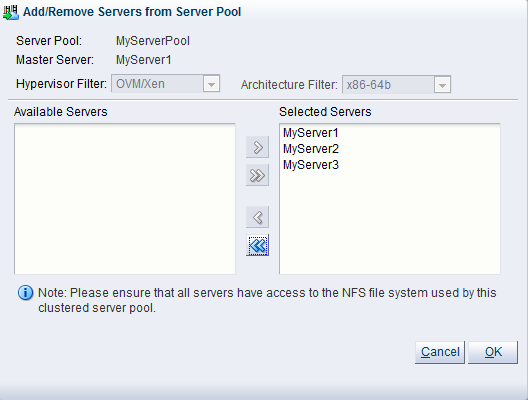
Select the Oracle VM Servers you want to add to the server pool from the Available Servers list box and move them to the Selected Servers list box. Click OK.
The server pool is updated to include new Oracle VM Servers.
When you want to remove resources in a server pool, perhaps to be used elsewhere, you can remove an Oracle VM Server from a server pool. Removing an Oracle VM Server from a server pool does not delete it, but places it in the unconfigured state.
Before you can remove an Oracle VM Server from a server pool, it must be suspended from participating in all server pool roles and all virtual machines stopped or migrated. To automatically migrate the running virtual machines and suspend all server pool roles, place the Oracle VM Server in maintenance mode. See Section 6.9.10, “Placing an Oracle VM Server into Maintenance Mode” for information on putting an Oracle VM Server into maintenance mode.
Removing an Oracle VM Server from a server pool requires modification of both cluster configuration information and server pool information on all Oracle VM Servers in the server pool. This is performed automatically.
To remove Oracle VM Servers from a server pool:
Click the Servers and VMs tab.
Select the server pool in the Server Pools folder in the navigation pane. Click Add/Remove Servers from Server Pool...
 in the toolbar. The Add/Remove Servers
from Server Pool dialog box is displayed.
in the toolbar. The Add/Remove Servers
from Server Pool dialog box is displayed.

Select the Oracle VM Servers you want to remove from the server pool from the Selected Servers list box and move them to the Available Servers list box. Click OK.
The server pool is updated and the Oracle VM Servers are removed and placed in the Unassigned Servers folder in the navigation tree.
You can edit the configuration information of a server pool, including the server pool name, description, and key mapping. You can also change the master server, which controls the cluster, as well as whether the virtual machines are migrated securely. You cannot change the virtual IP address or the file system used for the server pool.
To add or remove Oracle VM Servers from a server pool, see Section 6.8.1, “Adding an Oracle VM Server to a Server Pool” and Section 6.8.2, “Removing an Oracle VM Server from a Server Pool”.
To edit a server pool:
Click the Servers and VMs tab.
Select the server pool in the Server Pools folder in the navigation pane. Click Edit Selected Server Pool...
 in the toolbar. The Edit Server
Pool dialog box is displayed.
in the toolbar. The Edit Server
Pool dialog box is displayed.
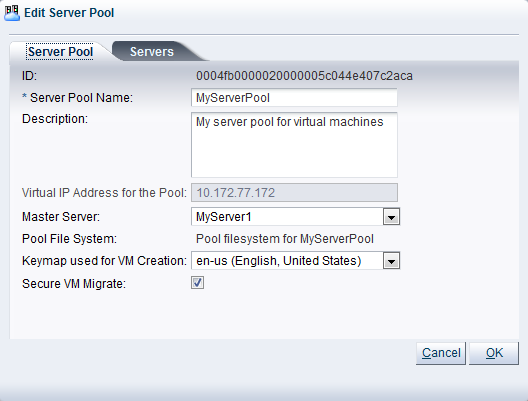
Edit the server pool information:
Server Pool Name: The name of the server pool. The maximum length of a server pool name is 256 characters and may contain any character.
Description: A description of the server pool.
Virtual IP Address for the Pool: This field cannot be modified.
Master Server: The master server that handles interactions with Oracle VM Manager.
Pool File System: This field cannot be modified.
Keymap used for VM Creation: The key mapping to use in the consoles for all virtual machines in the server pool.
Secure VM Migrate: Select whether to enable encrypted migration of virtual machines.
To edit the servers in the server pool, select the server in the navigation pane and click the Servers tab.

For more information on the tabs in this wizard, see Section 6.7, “Creating a Server Pool”.
Click OK.
The server pool changes are automatically propagated to all Oracle VM Servers in the server pool by the master server.
Oracle VM Manager allows you to change the password for the Oracle VM Agent running on each Oracle VM Server. However, you must change the Oracle VM Agent password for all Oracle VM Servers in a server pool. This is why the password change can only be executed at the server pool level and is applied to all Oracle VM Servers in the server pool at the same time.
To change the Oracle VM Agent password for all Oracle VM Servers in a server pool:
Click the Servers and VMs tab.
In the navigation pane, select the server pool for which you want to change the Oracle VM Agent password. Click Change Servers Agent Password
 in the toolbar. The Change Agent
Password for All Servers within the Server Pool
dialog box is displayed.
in the toolbar. The Change Agent
Password for All Servers within the Server Pool
dialog box is displayed.
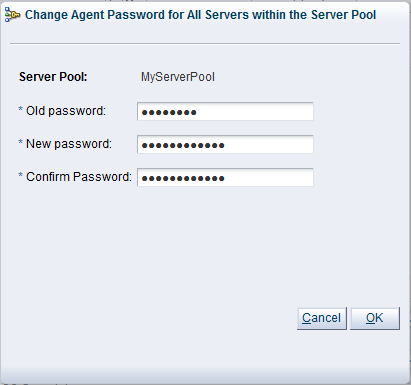
Enter the current password first. Then enter a new password and confirm it in the respective fields.
Click OK to complete the operation. Oracle VM Manager logs into each Oracle VM Server in the server pool and changes the Oracle VM Agent password.
When you select a server pool in the navigation pane, the Policies view is available in the Perspective field in the management pane showing the power and resource utilization policy settings for the server pool. The two policies you can set are for:
Distributed Resource Scheduler (DRS): Optimizes virtual machine resource utilization in a server pool.
Distributed Power Management (DPM): Increases the consolidation ratio to use fewer Oracle VM Servers during periods of relative low resource utilization.
The policy is also able to be set for networks used in a server pool. You can set the server pool to use either DRS, or DPM, but not both at the same time.
See Section 6.5, “Server Pool Policies” for more information on these server pool policies.
To set or edit a server pool policy:
Click the Servers and VMs tab.
Select the server pool in the Server Pools folder in the navigation pane.
From the Perspective field in the management pane, select Policies from the drop-down list. Click Edit
 in the toolbar. The Configure
Policy step of the
Configure DRS/DPM wizard is
displayed.
in the toolbar. The Configure
Policy step of the
Configure DRS/DPM wizard is
displayed.

Enter the server pool policy information:
Policy Control:
Policy Type: You can choose from either DRS, DPM, or none. You cannot set both DRS and DPM to be active at the same time.
Time Period (Minutes): The time period for the policy job to run. This sets the policy job to run every n minutes, for example, 10 sets the policy job to run every 10 minutes. You can enter a number between 1 and 60.
Server CPU:
Enable: Set whether to enable or disable logging of CPU performance and utilization.
Threshold (%): The maximum amount of CPU percentage usage allowed before the policy must be enacted. You can enter between 0 and 99.
Servers: Select the Oracle VM Servers for which the policy is to be enabled by moving the selected Oracle VM Servers from the Available Servers to the Selected Servers shuttle box.
Click Next.
The Select Networks step of the Configure DRS/DPM wizard is displayed.
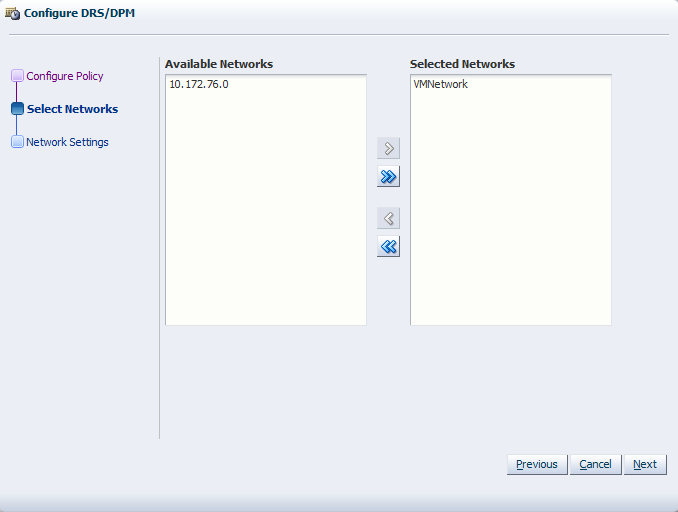
Select the networks to be included in the policy. Click Next.
The Network Settings step of the Configure DRS/DPM wizard is displayed.
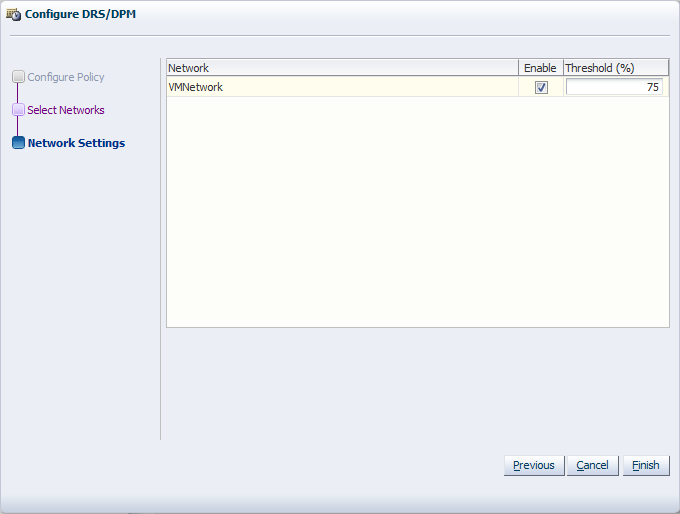
Select whether to enable the policy on the network, and select the threshold at which the policy is to be enacted for the network. Click Finish.
The policy is set for the server pool.
Before you can delete a server pool, you must delete all virtual machines and remove all Oracle VM Servers from the server pool.
To delete a virtual machine, see Section 7.9.11, “Deleting a Virtual Machine”. To remove an Oracle VM Server from a server pool, see Section 6.8.2, “Removing an Oracle VM Server from a Server Pool”.
To delete a server pool:
Click the Servers and VMs tab.
Select the server pool in the Server Pools folder in the navigation pane. Click Delete
 in the toolbar.
in the toolbar.
The Delete Confirmation dialog box is displayed.
Click OK to delete the server pool.
The server pool is deleted.
To delete a server pool which is HA-enabled, you must have an Admin server assigned to any NFS file server-based storage. See Section 4.6.1, “Discovering File Servers” for information on editing a file server to add an Admin server.